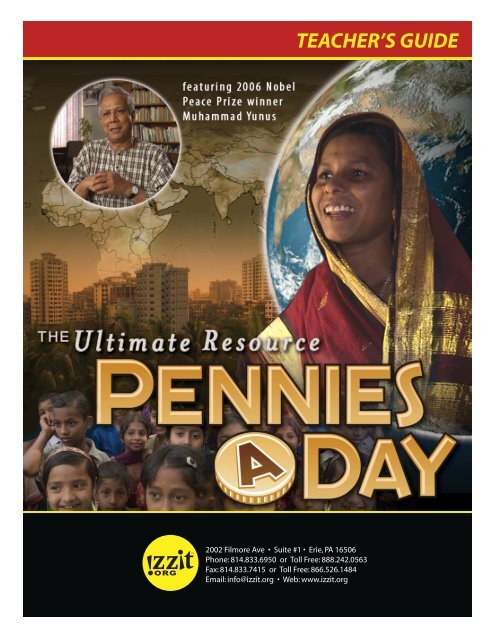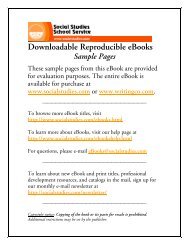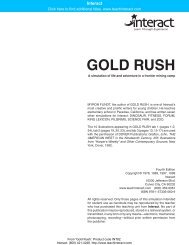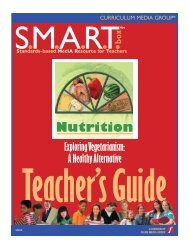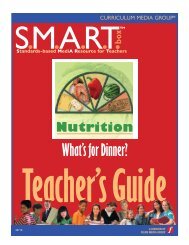Teacher's guide
Teacher's guide
Teacher's guide
- No tags were found...
Create successful ePaper yourself
Turn your PDF publications into a flip-book with our unique Google optimized e-Paper software.
2002 Filmore Ave • Suite #1 • Erie, PA 16506Phone: 814.833.6950 or Toll Free: 888.242.0563Fax: 814.833.7415 or Toll Free: 866.526.1484Email: info@izzit.org • Web: www.izzit.orgTEACHER’S GUIDE
Pennies A DayTeacher’s GuideThis Teacher’s Guide includes the following:● Preview Questions**● Post-viewing Discussion Questions**● Worksheet● Quiz● Extra Credit Ideas● Answer Key**Note: These are designed for you to read aloud. However, these could also be used as a handout.--------------------------------------------------------------------------------These materials may be used in a variety of ways. For maximum benefit, we suggest the followinglesson plan progression:● Discuss the Preview Questions.● Watch the video. Pause if and when you deem useful.● When the video ends, allow the students to react. Use the Post-viewing DiscussionQuestions to spark discussion.● Assign the Worksheet as an individual or small group classroom activity, or as ahomework assignment.● Discuss the correct responses to the Worksheet. (See the Answer Key)● Watch the video again and let your students know a quiz will immediately follow.● Distribute the Quiz. (See the Answer Key)*As a special bonus feature, this DVD includes a music video called “Hear Me Now” by TheGreen Children. The students may enjoy watching it after taking the quiz.● Assign optional Extra Credit Ideas.1
Name:Date:Pennies A DayPreview Questions1. What do you know about Bangladesh?2. Where is Bangladesh? (Locate it on a map.)3. How do you imagine life in rural Bangladesh?4. What do you think are the living conditions in Bangladesh?5. What do people do? What do they wear?6. What do you think can/should be done to help people out of poverty?2
Name:Date:Pennies A DayPost-viewing Discussion Questions1. Why is this video called Pennies a Day?2. What problems might arise as a result of half the population being under the age of 20?3. Would you have expected that illiterate women with no business experience could have startedtheir own successful ventures with very small loans? Why or why not?4. What were the social effects of financial success, particularly for women? How did financialsuccess affect the families and villages?5. Minara said, “In our village, poverty is gone.” Does this statement surprise you? Is the villagestill poor by our standards? Is poverty relative?6. What did Muhammad Yunus mean when he said it is creativity, not the loan, that matters?7. What obstacles made it hard for the villagers to escape poverty before Grameen Bank? Whatwere their options?8. Why are initial loans always for income-producing projects?9. Why was there initial opposition to Grameen in this mostly-Muslim country?10. How does the Grameen system manage such a high payback rate on its loans in spite ofrequiring no collateral and no legal contract?11. According to Muhammad Yunus, women have a longer vision. Explain.12. Would microcredit work in America? Is it needed in America?3
Name:Pennies A DayWorksheetDate:1. Of 140 million Bangladeshis, half are below what age?2. What amount of money per day did 70% of the people of Bangladesh live on?3. To what does Muhammad Yunus compare poverty? Why?4. What were some problems with borrowing from traditional moneylenders?5. How much were the original Grameen loans?6. What does Grameen mean?7. What prestigious prize was awarded to Muhammad Yunus and the Grameen project in 2006?8. What is microcredit?9. Who receives 96% of Grameen loans in this mostly-Muslim country?10. What factors help Grameen to achieve a 99% payback rate on the loans?11. What are some examples of the 16 Decisions that are recited at each center meeting?12. How are the loans used? Give examples.4
Name:Pennies A DayQuizDate:1. In its first thirty years, 70% of the people of Bangladesh lived on less than _________ a day.a. $100b. $10c. $1d. 10 cents2. Grameen means _______________________.a. Urbanb. Povertyc. Rurald. Peace3. Muhammad Yunus and Grameen Bank won the ____________________________ in 2006.4. True or False: Initial loans are always for income-producing projects. _________5. True or False: Most Grameen loans go to men because they have a longer vision. _________6. Despite the fact that Grameen loans require no contract and no collateral, there is a _______%payback rate.a. 100b. 99c. 75d. 507. Minara Begum said, “In our village, ___________________ is gone.”8. What is microcredit?9. Give two examples of Grameen loan projects.10. Name two of the 16 Decisions that are recited at each center meeting.5
Pennies A DayExtra Credit Ideas1. Research and report on one of the following topics:● The 2006 Nobel Peace Prize being awarded to Muhammad Yunus and Grameen Bank● The growth and impact of microcredit around the world● The role of women in Muslim societies2. If you could get a microloan, what type of business would you start? Formulate a plan for anincome-producing project you could undertake with a microloan.6
Pennies A DayAnswer KeyWorksheet1. 202. Less than $1 per day3. Darkness4. High interest rates; conditions, such as “you must sell your product to me at a certain price”5. $0.64 each or $27 total6. Rural7. The Nobel Peace Prize (or Nobel Prize)8. Giving very small loans to poor people to enable them to create their own businesses9. Women10. Peer pressure and individual pride11. Cleanliness, balanced meals, family planning, working hard12. Livestock, agriculture, cell phones, loom, poultry, grocery shopsQuiz1. c2. c3. The Nobel Peace Prize (or Nobel Prize)4. True5. False (Women)6. b7. Poverty8. Giving very small loans to poor people enabling them to start their own business9. Livestock, agriculture, cell phones, loom, poultry, grocery shops10. Cleanliness, balanced meals, family planning, working hard7
We are very interested to learnhow you use our material. Pleaseshare your experiences or lessonplan ideas by emailing usat info@izzit.org.2002 Filmore Ave • Suite #1 • Erie, PA 16506Phone: 814.833.6950 or Toll Free: 888.242.0563Fax: 814.833.7415 or Toll Free: 866.526.1484Email: info@izzit.org • Web: www.izzit.org


